BSBRSK501 - Risk Management: Implementing AS/NZ ISO 31000:2009
VerifiedAdded on 2023/06/16
|22
|3836
|140
Homework Assignment
AI Summary
This assignment solution provides a comprehensive overview of risk management principles and processes, focusing on the application of the AS/NZ ISO 31000:2009 standard within the context of Global Star Enterprises (GSE). It addresses key aspects such as establishing goals, identifying and analyzing risks, evaluating potential impacts, and developing treatment strategies. The solution includes a stakeholder analysis template, SWOT analysis, and explores political, economic, social, legal, and technological impacts on the organization. Furthermore, it details communication strategies for engaging various stakeholders and emphasizes the importance of monitoring and reviewing risk management plans for successful implementation. The document also covers research methods for risk identification and scenario planning techniques. Desklib offers a wide range of study tools and resources, including solved assignments and past papers, to support students in their academic endeavors.
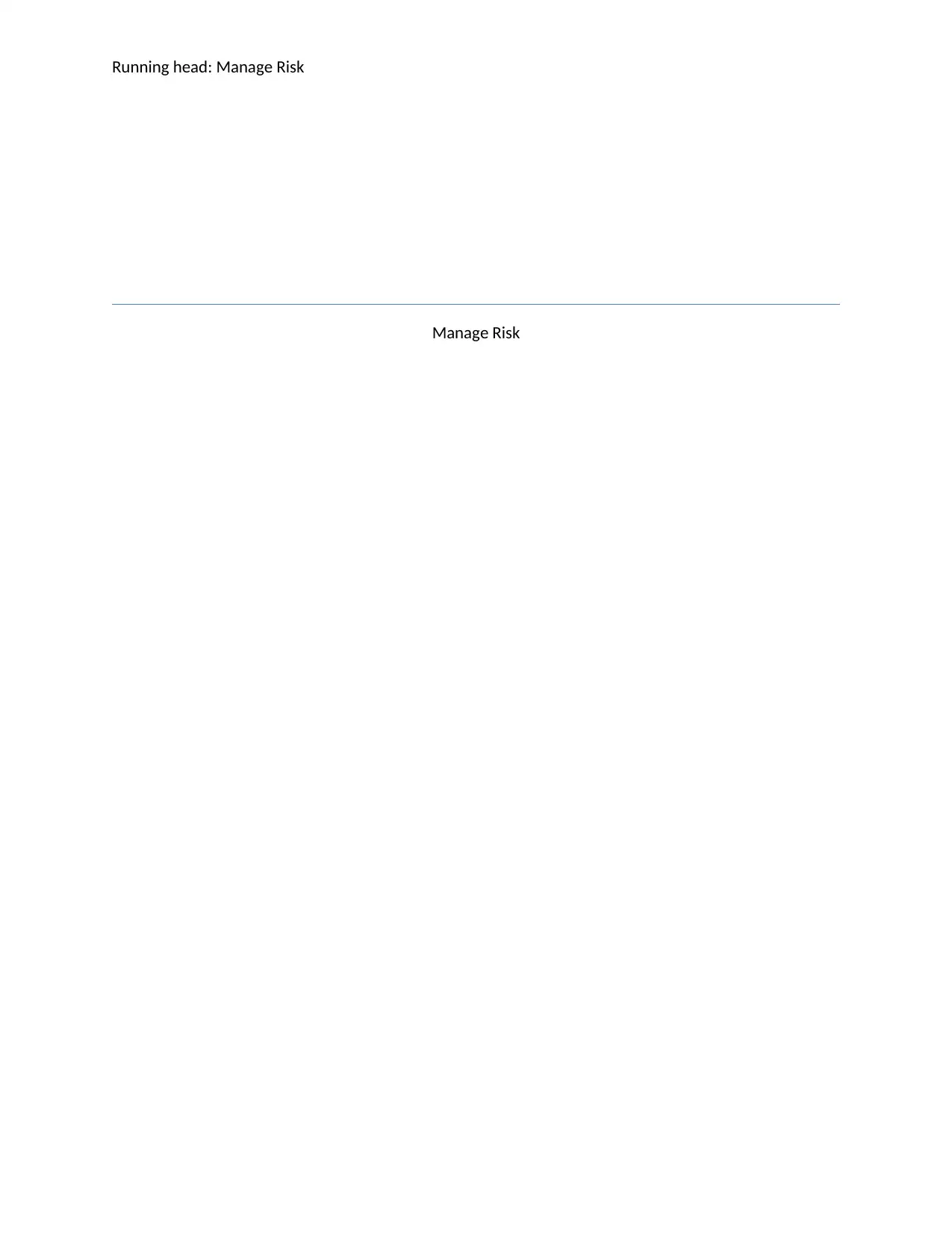
Running head: Manage Risk
Manage Risk
Manage Risk
Paraphrase This Document
Need a fresh take? Get an instant paraphrase of this document with our AI Paraphraser
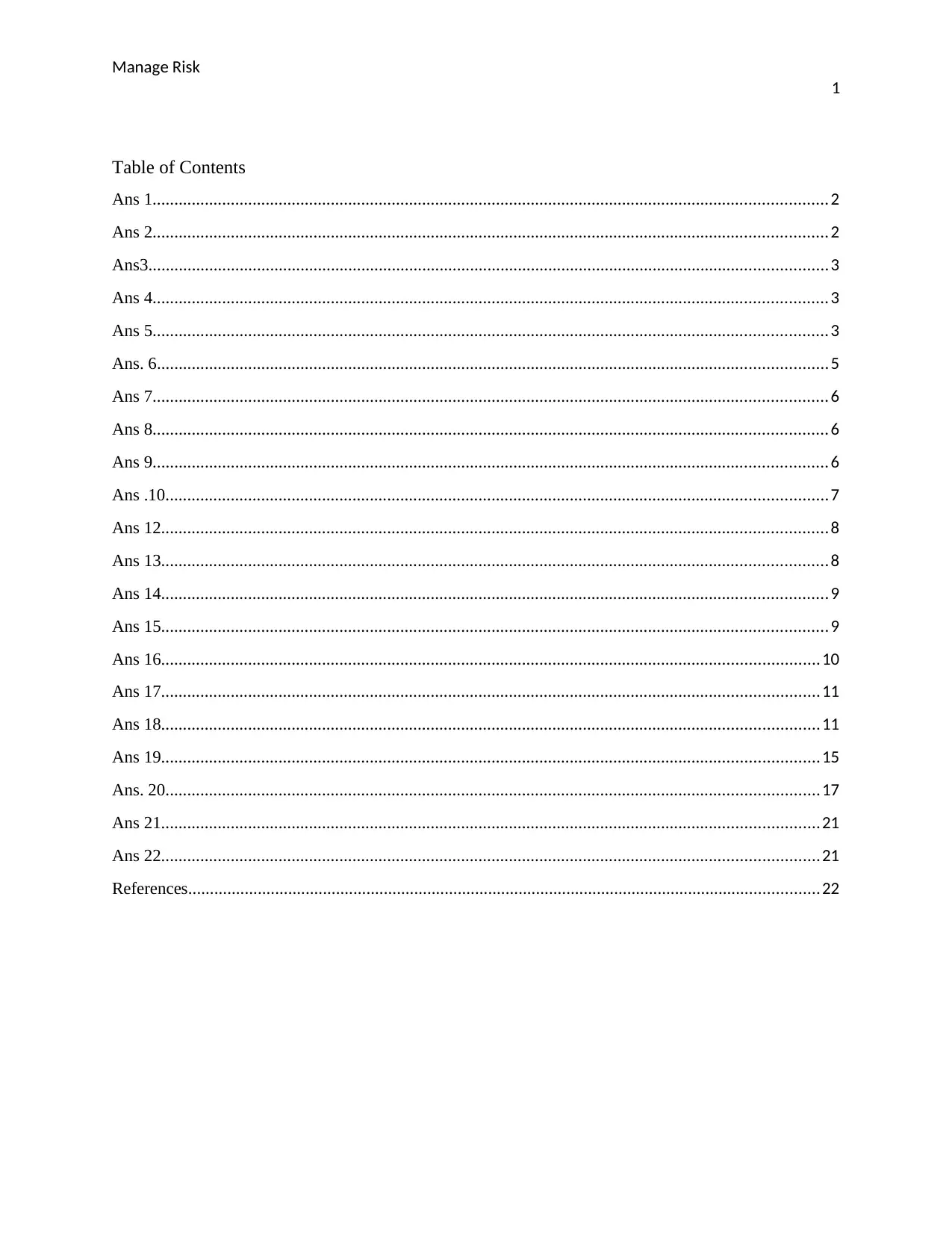
Manage Risk
1
Table of Contents
Ans 1...........................................................................................................................................................2
Ans 2...........................................................................................................................................................2
Ans3............................................................................................................................................................3
Ans 4...........................................................................................................................................................3
Ans 5...........................................................................................................................................................3
Ans. 6..........................................................................................................................................................5
Ans 7...........................................................................................................................................................6
Ans 8...........................................................................................................................................................6
Ans 9...........................................................................................................................................................6
Ans .10........................................................................................................................................................7
Ans 12.........................................................................................................................................................8
Ans 13.........................................................................................................................................................8
Ans 14.........................................................................................................................................................9
Ans 15.........................................................................................................................................................9
Ans 16.......................................................................................................................................................10
Ans 17.......................................................................................................................................................11
Ans 18.......................................................................................................................................................11
Ans 19.......................................................................................................................................................15
Ans. 20......................................................................................................................................................17
Ans 21.......................................................................................................................................................21
Ans 22.......................................................................................................................................................21
References.................................................................................................................................................22
1
Table of Contents
Ans 1...........................................................................................................................................................2
Ans 2...........................................................................................................................................................2
Ans3............................................................................................................................................................3
Ans 4...........................................................................................................................................................3
Ans 5...........................................................................................................................................................3
Ans. 6..........................................................................................................................................................5
Ans 7...........................................................................................................................................................6
Ans 8...........................................................................................................................................................6
Ans 9...........................................................................................................................................................6
Ans .10........................................................................................................................................................7
Ans 12.........................................................................................................................................................8
Ans 13.........................................................................................................................................................8
Ans 14.........................................................................................................................................................9
Ans 15.........................................................................................................................................................9
Ans 16.......................................................................................................................................................10
Ans 17.......................................................................................................................................................11
Ans 18.......................................................................................................................................................11
Ans 19.......................................................................................................................................................15
Ans. 20......................................................................................................................................................17
Ans 21.......................................................................................................................................................21
Ans 22.......................................................................................................................................................21
References.................................................................................................................................................22
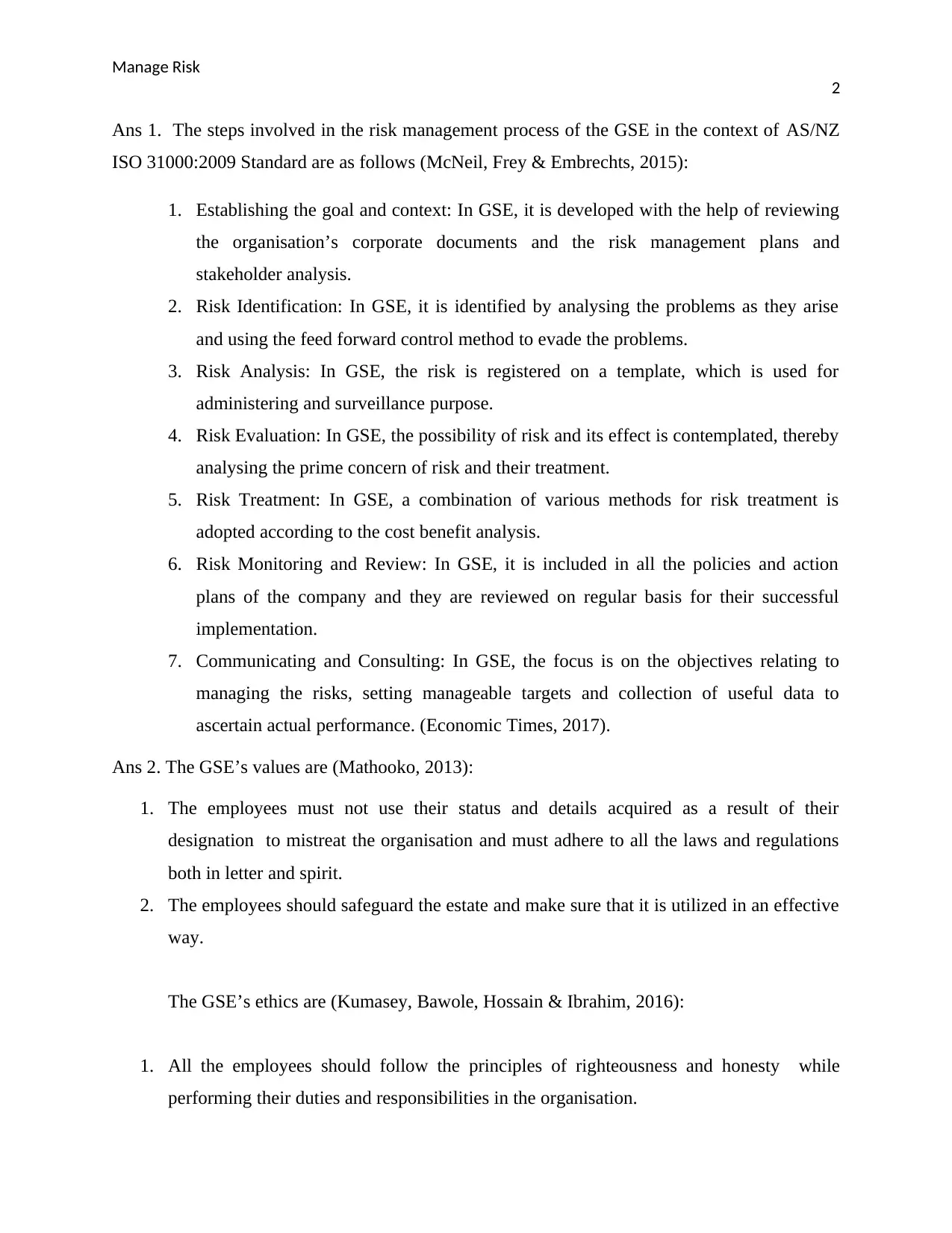
Manage Risk
2
Ans 1. The steps involved in the risk management process of the GSE in the context of AS/NZ
ISO 31000:2009 Standard are as follows (McNeil, Frey & Embrechts, 2015):
1. Establishing the goal and context: In GSE, it is developed with the help of reviewing
the organisation’s corporate documents and the risk management plans and
stakeholder analysis.
2. Risk Identification: In GSE, it is identified by analysing the problems as they arise
and using the feed forward control method to evade the problems.
3. Risk Analysis: In GSE, the risk is registered on a template, which is used for
administering and surveillance purpose.
4. Risk Evaluation: In GSE, the possibility of risk and its effect is contemplated, thereby
analysing the prime concern of risk and their treatment.
5. Risk Treatment: In GSE, a combination of various methods for risk treatment is
adopted according to the cost benefit analysis.
6. Risk Monitoring and Review: In GSE, it is included in all the policies and action
plans of the company and they are reviewed on regular basis for their successful
implementation.
7. Communicating and Consulting: In GSE, the focus is on the objectives relating to
managing the risks, setting manageable targets and collection of useful data to
ascertain actual performance. (Economic Times, 2017).
Ans 2. The GSE’s values are (Mathooko, 2013):
1. The employees must not use their status and details acquired as a result of their
designation to mistreat the organisation and must adhere to all the laws and regulations
both in letter and spirit.
2. The employees should safeguard the estate and make sure that it is utilized in an effective
way.
The GSE’s ethics are (Kumasey, Bawole, Hossain & Ibrahim, 2016):
1. All the employees should follow the principles of righteousness and honesty while
performing their duties and responsibilities in the organisation.
2
Ans 1. The steps involved in the risk management process of the GSE in the context of AS/NZ
ISO 31000:2009 Standard are as follows (McNeil, Frey & Embrechts, 2015):
1. Establishing the goal and context: In GSE, it is developed with the help of reviewing
the organisation’s corporate documents and the risk management plans and
stakeholder analysis.
2. Risk Identification: In GSE, it is identified by analysing the problems as they arise
and using the feed forward control method to evade the problems.
3. Risk Analysis: In GSE, the risk is registered on a template, which is used for
administering and surveillance purpose.
4. Risk Evaluation: In GSE, the possibility of risk and its effect is contemplated, thereby
analysing the prime concern of risk and their treatment.
5. Risk Treatment: In GSE, a combination of various methods for risk treatment is
adopted according to the cost benefit analysis.
6. Risk Monitoring and Review: In GSE, it is included in all the policies and action
plans of the company and they are reviewed on regular basis for their successful
implementation.
7. Communicating and Consulting: In GSE, the focus is on the objectives relating to
managing the risks, setting manageable targets and collection of useful data to
ascertain actual performance. (Economic Times, 2017).
Ans 2. The GSE’s values are (Mathooko, 2013):
1. The employees must not use their status and details acquired as a result of their
designation to mistreat the organisation and must adhere to all the laws and regulations
both in letter and spirit.
2. The employees should safeguard the estate and make sure that it is utilized in an effective
way.
The GSE’s ethics are (Kumasey, Bawole, Hossain & Ibrahim, 2016):
1. All the employees should follow the principles of righteousness and honesty while
performing their duties and responsibilities in the organisation.
⊘ This is a preview!⊘
Do you want full access?
Subscribe today to unlock all pages.

Trusted by 1+ million students worldwide

Manage Risk
3
2. The environment within the organisation is healthy and of mutual faith .It acknowledges
the integrity of the personnel and right to a workplace free from exploitation.
3. The policy of whistle blowing is adopted and the misconduct and the frauds are reported
to the CEO.
The GSE’s mission is (Papulova, 2014, pp .12):
All its employees should be environmentally aware and economically feasible while supplying
goods and amenities to the customers which satisfy their needs fully.
Ans3. The company aims at expanding its market into South East Asia and product and
showroom expansion strategy and installation, for which, the new project team is proposed to
be established in Singapore, where there is an opportunity to target the budget sensitive
companies. If the reserves used for expansion are inadequate, then it shall be opting for its listing
on the Australian stock exchange, which is a time consuming process. So, in this context, it has
to implement the plan comprising of risk arising from budget constraints, i.e. risk identification,
analysis, treatment, monitoring, review, communication and consulting (OECD, 2014).
Ans4. As the risk management process defines the identification of risk at its initial stage and
strategizes its response and supervises its execution. (Pritchard, PMP, PMI-RMP & EVP,
2014).As the Sales Manager at the GSE South Australian branch, I would implement the risk
management plan by identifying the risk posed by new competitor in the market. The fact that in
South Australia, there are many competitors who sell similar products at low prices and better
quality can pose a threat to the firm. So a risk management plan comprising of processes which
would minimize the cost of production and increase the sales thereby protecting the interests of
the company (“The National Archives .Risk Assessment Handbook,”2014).
Ans 5. (Schmeer, 2017) STAKEHOLDER AGENDA ANALYSIS TEMPLATE
3
2. The environment within the organisation is healthy and of mutual faith .It acknowledges
the integrity of the personnel and right to a workplace free from exploitation.
3. The policy of whistle blowing is adopted and the misconduct and the frauds are reported
to the CEO.
The GSE’s mission is (Papulova, 2014, pp .12):
All its employees should be environmentally aware and economically feasible while supplying
goods and amenities to the customers which satisfy their needs fully.
Ans3. The company aims at expanding its market into South East Asia and product and
showroom expansion strategy and installation, for which, the new project team is proposed to
be established in Singapore, where there is an opportunity to target the budget sensitive
companies. If the reserves used for expansion are inadequate, then it shall be opting for its listing
on the Australian stock exchange, which is a time consuming process. So, in this context, it has
to implement the plan comprising of risk arising from budget constraints, i.e. risk identification,
analysis, treatment, monitoring, review, communication and consulting (OECD, 2014).
Ans4. As the risk management process defines the identification of risk at its initial stage and
strategizes its response and supervises its execution. (Pritchard, PMP, PMI-RMP & EVP,
2014).As the Sales Manager at the GSE South Australian branch, I would implement the risk
management plan by identifying the risk posed by new competitor in the market. The fact that in
South Australia, there are many competitors who sell similar products at low prices and better
quality can pose a threat to the firm. So a risk management plan comprising of processes which
would minimize the cost of production and increase the sales thereby protecting the interests of
the company (“The National Archives .Risk Assessment Handbook,”2014).
Ans 5. (Schmeer, 2017) STAKEHOLDER AGENDA ANALYSIS TEMPLATE
Paraphrase This Document
Need a fresh take? Get an instant paraphrase of this document with our AI Paraphraser

Manage Risk
4
Our Goal: To be a preferable organization for all and to be economically feasible while
supplying goods and amenities to the customers which satisfy their needs fully.
Stakeholder Stakeholder’s
agenda for Agency
Strengths in
meeting agenda
Vulnerability resulting from
the agenda
Managers
Innovation and
growth of the
company.
Expansion of the
business
internationally.
The political and legal policies
of the client country along
with technological
Shareholders
Good Capital
growth, regular
flow of income and
the continuity of
the business.
Increased
profitability of the
company.
If the capital growth increases,
the shareholders will anticipate
better returns from the
business.
Suppliers
The suppliers
should be paid
timely.
Timely payment to
the creditors will
result in
undisturbed
distribution of
goods.
The postponement in the
payment to increase the
liquidity may result in
disruption in the supply of
goods.
Customers
The organization is
expected to be
customer centric.
Customer
satisfaction is
achieved through
supply of value for
products.
Any effort to deliver best
quality products may result in
increased prices leading to
consumer discontentment.
4
Our Goal: To be a preferable organization for all and to be economically feasible while
supplying goods and amenities to the customers which satisfy their needs fully.
Stakeholder Stakeholder’s
agenda for Agency
Strengths in
meeting agenda
Vulnerability resulting from
the agenda
Managers
Innovation and
growth of the
company.
Expansion of the
business
internationally.
The political and legal policies
of the client country along
with technological
Shareholders
Good Capital
growth, regular
flow of income and
the continuity of
the business.
Increased
profitability of the
company.
If the capital growth increases,
the shareholders will anticipate
better returns from the
business.
Suppliers
The suppliers
should be paid
timely.
Timely payment to
the creditors will
result in
undisturbed
distribution of
goods.
The postponement in the
payment to increase the
liquidity may result in
disruption in the supply of
goods.
Customers
The organization is
expected to be
customer centric.
Customer
satisfaction is
achieved through
supply of value for
products.
Any effort to deliver best
quality products may result in
increased prices leading to
consumer discontentment.
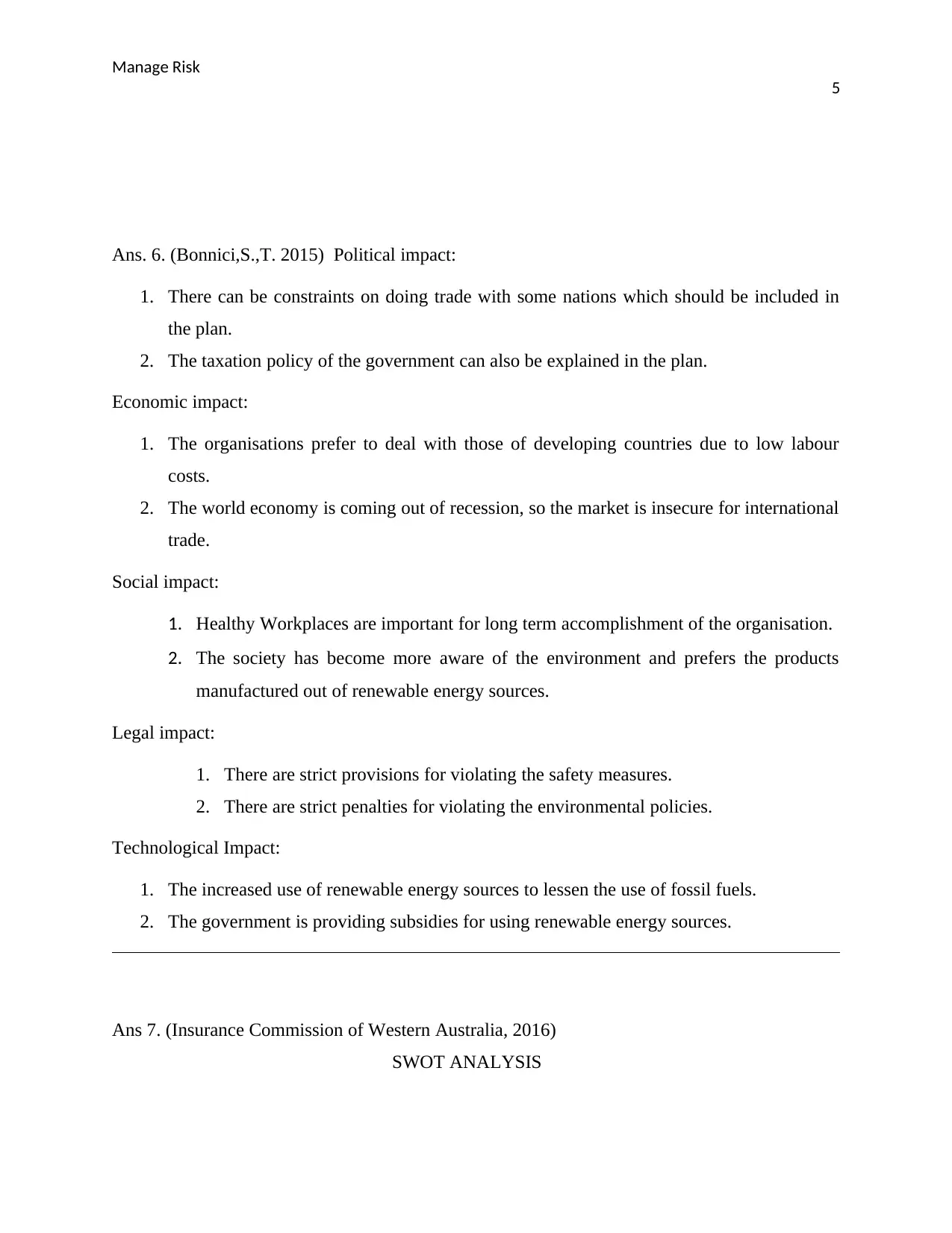
Manage Risk
5
Ans. 6. (Bonnici,S.,T. 2015) Political impact:
1. There can be constraints on doing trade with some nations which should be included in
the plan.
2. The taxation policy of the government can also be explained in the plan.
Economic impact:
1. The organisations prefer to deal with those of developing countries due to low labour
costs.
2. The world economy is coming out of recession, so the market is insecure for international
trade.
Social impact:
1. Healthy Workplaces are important for long term accomplishment of the organisation.
2. The society has become more aware of the environment and prefers the products
manufactured out of renewable energy sources.
Legal impact:
1. There are strict provisions for violating the safety measures.
2. There are strict penalties for violating the environmental policies.
Technological Impact:
1. The increased use of renewable energy sources to lessen the use of fossil fuels.
2. The government is providing subsidies for using renewable energy sources.
Ans 7. (Insurance Commission of Western Australia, 2016)
SWOT ANALYSIS
5
Ans. 6. (Bonnici,S.,T. 2015) Political impact:
1. There can be constraints on doing trade with some nations which should be included in
the plan.
2. The taxation policy of the government can also be explained in the plan.
Economic impact:
1. The organisations prefer to deal with those of developing countries due to low labour
costs.
2. The world economy is coming out of recession, so the market is insecure for international
trade.
Social impact:
1. Healthy Workplaces are important for long term accomplishment of the organisation.
2. The society has become more aware of the environment and prefers the products
manufactured out of renewable energy sources.
Legal impact:
1. There are strict provisions for violating the safety measures.
2. There are strict penalties for violating the environmental policies.
Technological Impact:
1. The increased use of renewable energy sources to lessen the use of fossil fuels.
2. The government is providing subsidies for using renewable energy sources.
Ans 7. (Insurance Commission of Western Australia, 2016)
SWOT ANALYSIS
⊘ This is a preview!⊘
Do you want full access?
Subscribe today to unlock all pages.

Trusted by 1+ million students worldwide

Manage Risk
6
SWOT Analysis: Global Star Enterprises
Strengths Weaknesses
Reliable Quality
Experienced Executive Board.
Low labour cost as compared to competitors.
Outstanding hand carving skills of the
workforce.
Lack of accessibility to the customers.
Lack of funds.
High import duty on timber and import of
wood.
Insufficient wood seasoning arrangement.
Opportunities Threats
Growth in the market.
Customer Reliability.
Expansion of products.
Elevation of terrestrial markets.
Competitors in the market.
Change in the policies of the government.
Change in the taste of the customers.
New distribution channels.
Ans 8. (Cooper, 2013, pp. 5) The company aims at making consumer centric policies and
supplies economically feasible yet best quality products to the customer’s .It should endeavour to
outperform as the foremost authorization over its area of operation in spite of the competition. In
spite of the competition, customers will demand best solutions for their certain necessities. So, it
should manufacture USP to attract its customers.
Ans 9. (University of Turku, 2016)
1. For proper execution of the action plan, a team of professionals should be formed to supervise
its implementation.
2. The cost and benefits associated with the implementation of the plan should be strictly
monitored.
3. Proper treatment strategies of the risk implement plan should be executed.
6
SWOT Analysis: Global Star Enterprises
Strengths Weaknesses
Reliable Quality
Experienced Executive Board.
Low labour cost as compared to competitors.
Outstanding hand carving skills of the
workforce.
Lack of accessibility to the customers.
Lack of funds.
High import duty on timber and import of
wood.
Insufficient wood seasoning arrangement.
Opportunities Threats
Growth in the market.
Customer Reliability.
Expansion of products.
Elevation of terrestrial markets.
Competitors in the market.
Change in the policies of the government.
Change in the taste of the customers.
New distribution channels.
Ans 8. (Cooper, 2013, pp. 5) The company aims at making consumer centric policies and
supplies economically feasible yet best quality products to the customer’s .It should endeavour to
outperform as the foremost authorization over its area of operation in spite of the competition. In
spite of the competition, customers will demand best solutions for their certain necessities. So, it
should manufacture USP to attract its customers.
Ans 9. (University of Turku, 2016)
1. For proper execution of the action plan, a team of professionals should be formed to supervise
its implementation.
2. The cost and benefits associated with the implementation of the plan should be strictly
monitored.
3. Proper treatment strategies of the risk implement plan should be executed.
Paraphrase This Document
Need a fresh take? Get an instant paraphrase of this document with our AI Paraphraser

Manage Risk
7
Ans .10 (Australian Government .Department of Finance, 2016)
1. The middle level management can be communicated through meetings and e-mails about
the expansion strategy and the risks associated with it
2. The shareholders should be invited to discuss about the plan and their suggestions should
be implemented for its better performance, through conference calls and informal means
of communications.
3. The risk and management committee should be invited for reviews pertaining to the plan,
through voice –mails and electronic communication.
4. The employees should be invited for participation through formal means like
meetings ,conference calls and informal means like lunch meetings and voice mails for
the execution of the plan as human resources are a crucial part of the organisation
Ans 11
Name of the party Methods for their invitation Reasons for their invitation
Marketing Manager Through electronic
communication
He will explain the threats
related to introduction of new
competitors in the market.
Finance Manager Through electronic
communication
He will explain the dangers
related to maintaining the
appropriate debt equity ratio.
I.T. Manager Through electronic
communication
He will explain the threats
related to the technology
obsolescence.
Sales Manager Through electronic
communication
He will explain the danger
posed by competitors resulting
in decreased volume of sales.
Administration Manager Through electronic
communication
He will explain the threats
related to the internal
mismanagement.
7
Ans .10 (Australian Government .Department of Finance, 2016)
1. The middle level management can be communicated through meetings and e-mails about
the expansion strategy and the risks associated with it
2. The shareholders should be invited to discuss about the plan and their suggestions should
be implemented for its better performance, through conference calls and informal means
of communications.
3. The risk and management committee should be invited for reviews pertaining to the plan,
through voice –mails and electronic communication.
4. The employees should be invited for participation through formal means like
meetings ,conference calls and informal means like lunch meetings and voice mails for
the execution of the plan as human resources are a crucial part of the organisation
Ans 11
Name of the party Methods for their invitation Reasons for their invitation
Marketing Manager Through electronic
communication
He will explain the threats
related to introduction of new
competitors in the market.
Finance Manager Through electronic
communication
He will explain the dangers
related to maintaining the
appropriate debt equity ratio.
I.T. Manager Through electronic
communication
He will explain the threats
related to the technology
obsolescence.
Sales Manager Through electronic
communication
He will explain the danger
posed by competitors resulting
in decreased volume of sales.
Administration Manager Through electronic
communication
He will explain the threats
related to the internal
mismanagement.
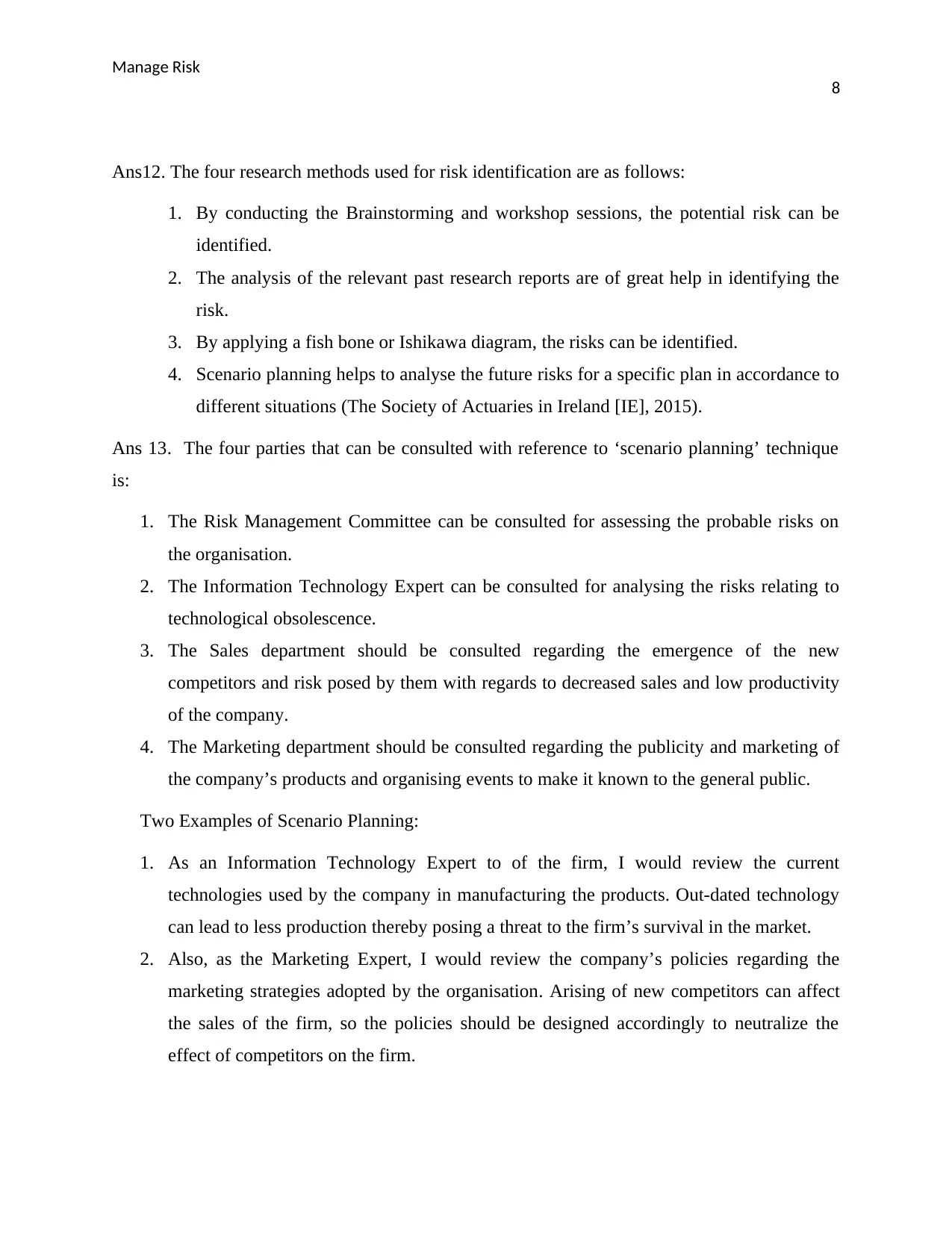
Manage Risk
8
Ans12. The four research methods used for risk identification are as follows:
1. By conducting the Brainstorming and workshop sessions, the potential risk can be
identified.
2. The analysis of the relevant past research reports are of great help in identifying the
risk.
3. By applying a fish bone or Ishikawa diagram, the risks can be identified.
4. Scenario planning helps to analyse the future risks for a specific plan in accordance to
different situations (The Society of Actuaries in Ireland [IE], 2015).
Ans 13. The four parties that can be consulted with reference to ‘scenario planning’ technique
is:
1. The Risk Management Committee can be consulted for assessing the probable risks on
the organisation.
2. The Information Technology Expert can be consulted for analysing the risks relating to
technological obsolescence.
3. The Sales department should be consulted regarding the emergence of the new
competitors and risk posed by them with regards to decreased sales and low productivity
of the company.
4. The Marketing department should be consulted regarding the publicity and marketing of
the company’s products and organising events to make it known to the general public.
Two Examples of Scenario Planning:
1. As an Information Technology Expert to of the firm, I would review the current
technologies used by the company in manufacturing the products. Out-dated technology
can lead to less production thereby posing a threat to the firm’s survival in the market.
2. Also, as the Marketing Expert, I would review the company’s policies regarding the
marketing strategies adopted by the organisation. Arising of new competitors can affect
the sales of the firm, so the policies should be designed accordingly to neutralize the
effect of competitors on the firm.
8
Ans12. The four research methods used for risk identification are as follows:
1. By conducting the Brainstorming and workshop sessions, the potential risk can be
identified.
2. The analysis of the relevant past research reports are of great help in identifying the
risk.
3. By applying a fish bone or Ishikawa diagram, the risks can be identified.
4. Scenario planning helps to analyse the future risks for a specific plan in accordance to
different situations (The Society of Actuaries in Ireland [IE], 2015).
Ans 13. The four parties that can be consulted with reference to ‘scenario planning’ technique
is:
1. The Risk Management Committee can be consulted for assessing the probable risks on
the organisation.
2. The Information Technology Expert can be consulted for analysing the risks relating to
technological obsolescence.
3. The Sales department should be consulted regarding the emergence of the new
competitors and risk posed by them with regards to decreased sales and low productivity
of the company.
4. The Marketing department should be consulted regarding the publicity and marketing of
the company’s products and organising events to make it known to the general public.
Two Examples of Scenario Planning:
1. As an Information Technology Expert to of the firm, I would review the current
technologies used by the company in manufacturing the products. Out-dated technology
can lead to less production thereby posing a threat to the firm’s survival in the market.
2. Also, as the Marketing Expert, I would review the company’s policies regarding the
marketing strategies adopted by the organisation. Arising of new competitors can affect
the sales of the firm, so the policies should be designed accordingly to neutralize the
effect of competitors on the firm.
⊘ This is a preview!⊘
Do you want full access?
Subscribe today to unlock all pages.

Trusted by 1+ million students worldwide

Manage Risk
9
Ans 14.
Nature of Risk
Probabilit
y of risk
Level of
risk
Reduction of Sales due
to competition. 5 extreme
Introduction of a new
competitor in the
market. 3 high
Critical system failure. 3 high
Death or severe injuries
to the labour due to
accidents. 5 extreme
Change in the political
policies. 3 high
Ans 15.
Nature of Risk Consequence of risk
Probability of
risk Level of risk
Reduction of Sales
due to competition.
The profit and revenue would be
decreased. 5 extreme
Introduction of a
new competitor in
the market.
Reduction in sales and hence the
decrease in revenue and profit
margin. 3 high
Critical system
failure.
It would result in the disruption of
the operations. 3 high
Death or severe Labour aggression and strike. 5 extreme
9
Ans 14.
Nature of Risk
Probabilit
y of risk
Level of
risk
Reduction of Sales due
to competition. 5 extreme
Introduction of a new
competitor in the
market. 3 high
Critical system failure. 3 high
Death or severe injuries
to the labour due to
accidents. 5 extreme
Change in the political
policies. 3 high
Ans 15.
Nature of Risk Consequence of risk
Probability of
risk Level of risk
Reduction of Sales
due to competition.
The profit and revenue would be
decreased. 5 extreme
Introduction of a
new competitor in
the market.
Reduction in sales and hence the
decrease in revenue and profit
margin. 3 high
Critical system
failure.
It would result in the disruption of
the operations. 3 high
Death or severe Labour aggression and strike. 5 extreme
Paraphrase This Document
Need a fresh take? Get an instant paraphrase of this document with our AI Paraphraser
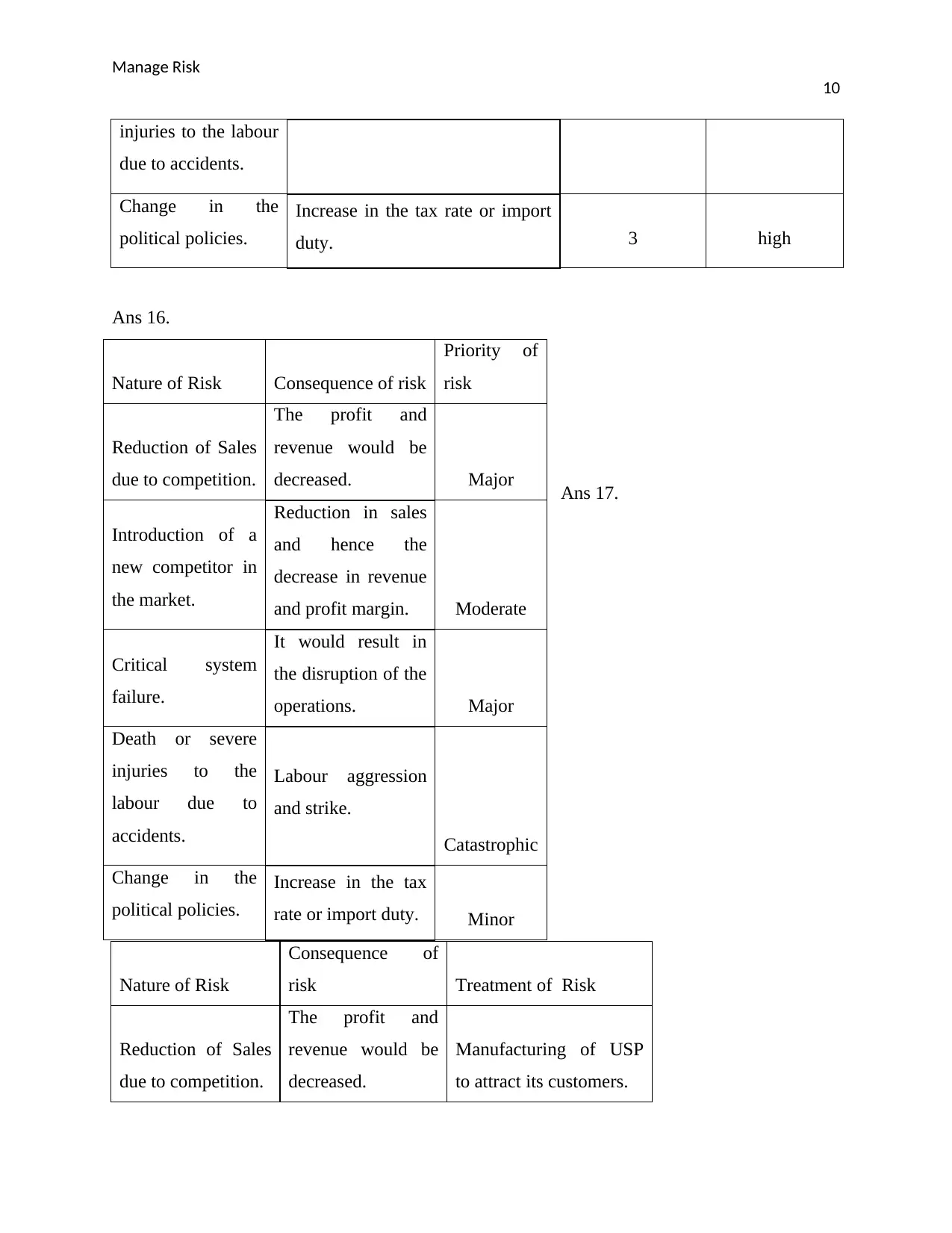
Manage Risk
10
injuries to the labour
due to accidents.
Change in the
political policies.
Increase in the tax rate or import
duty. 3 high
Ans 16.
Ans 17.
Nature of Risk
Consequence of
risk Treatment of Risk
Reduction of Sales
due to competition.
The profit and
revenue would be
decreased.
Manufacturing of USP
to attract its customers.
Nature of Risk Consequence of risk
Priority of
risk
Reduction of Sales
due to competition.
The profit and
revenue would be
decreased. Major
Introduction of a
new competitor in
the market.
Reduction in sales
and hence the
decrease in revenue
and profit margin. Moderate
Critical system
failure.
It would result in
the disruption of the
operations. Major
Death or severe
injuries to the
labour due to
accidents.
Labour aggression
and strike.
Catastrophic
Change in the
political policies.
Increase in the tax
rate or import duty. Minor
10
injuries to the labour
due to accidents.
Change in the
political policies.
Increase in the tax rate or import
duty. 3 high
Ans 16.
Ans 17.
Nature of Risk
Consequence of
risk Treatment of Risk
Reduction of Sales
due to competition.
The profit and
revenue would be
decreased.
Manufacturing of USP
to attract its customers.
Nature of Risk Consequence of risk
Priority of
risk
Reduction of Sales
due to competition.
The profit and
revenue would be
decreased. Major
Introduction of a
new competitor in
the market.
Reduction in sales
and hence the
decrease in revenue
and profit margin. Moderate
Critical system
failure.
It would result in
the disruption of the
operations. Major
Death or severe
injuries to the
labour due to
accidents.
Labour aggression
and strike.
Catastrophic
Change in the
political policies.
Increase in the tax
rate or import duty. Minor
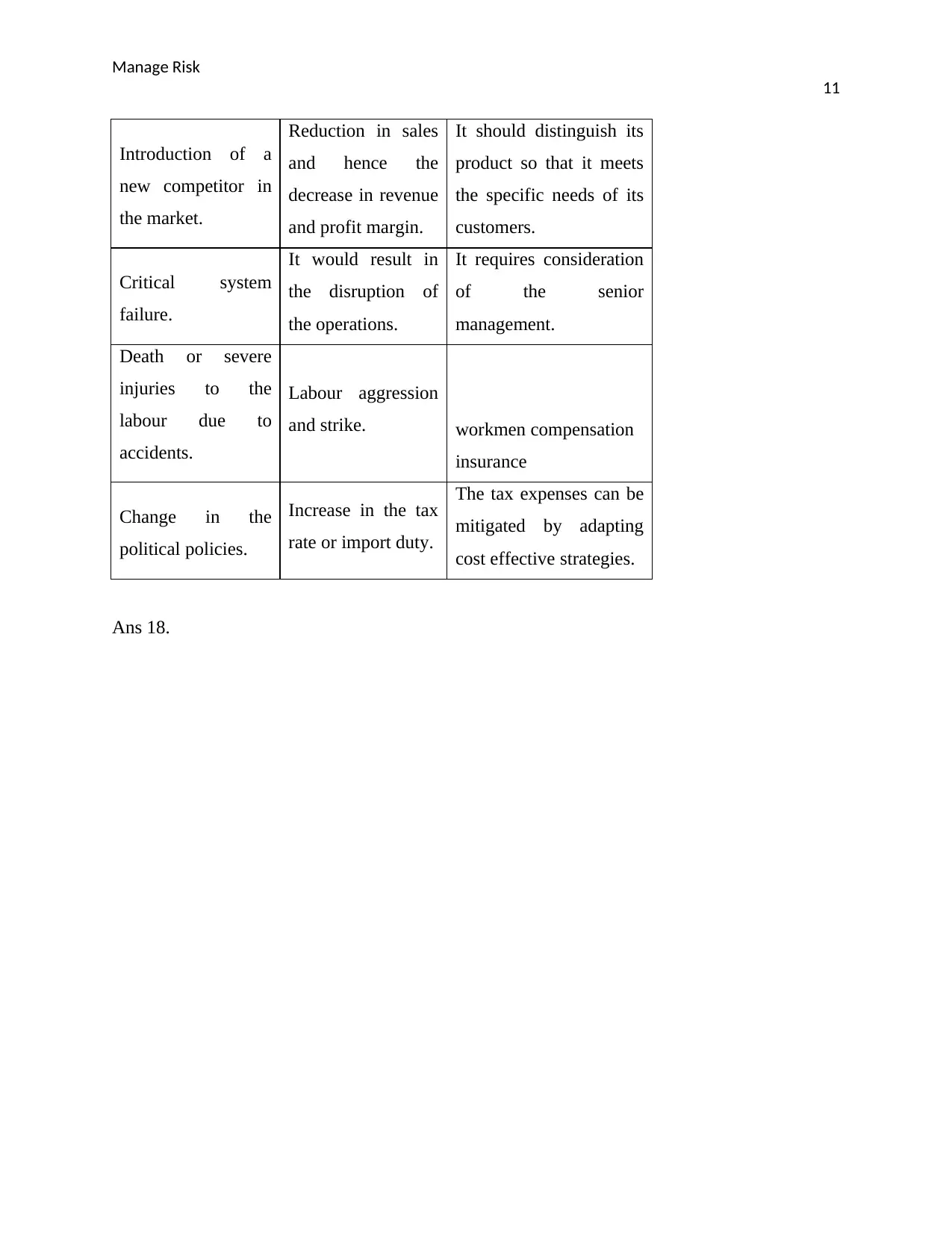
Manage Risk
11
Introduction of a
new competitor in
the market.
Reduction in sales
and hence the
decrease in revenue
and profit margin.
It should distinguish its
product so that it meets
the specific needs of its
customers.
Critical system
failure.
It would result in
the disruption of
the operations.
It requires consideration
of the senior
management.
Death or severe
injuries to the
labour due to
accidents.
Labour aggression
and strike. workmen compensation
insurance
Change in the
political policies.
Increase in the tax
rate or import duty.
The tax expenses can be
mitigated by adapting
cost effective strategies.
Ans 18.
11
Introduction of a
new competitor in
the market.
Reduction in sales
and hence the
decrease in revenue
and profit margin.
It should distinguish its
product so that it meets
the specific needs of its
customers.
Critical system
failure.
It would result in
the disruption of
the operations.
It requires consideration
of the senior
management.
Death or severe
injuries to the
labour due to
accidents.
Labour aggression
and strike. workmen compensation
insurance
Change in the
political policies.
Increase in the tax
rate or import duty.
The tax expenses can be
mitigated by adapting
cost effective strategies.
Ans 18.
⊘ This is a preview!⊘
Do you want full access?
Subscribe today to unlock all pages.

Trusted by 1+ million students worldwide
1 out of 22
Related Documents
Your All-in-One AI-Powered Toolkit for Academic Success.
+13062052269
info@desklib.com
Available 24*7 on WhatsApp / Email
![[object Object]](/_next/static/media/star-bottom.7253800d.svg)
Unlock your academic potential
Copyright © 2020–2025 A2Z Services. All Rights Reserved. Developed and managed by ZUCOL.





